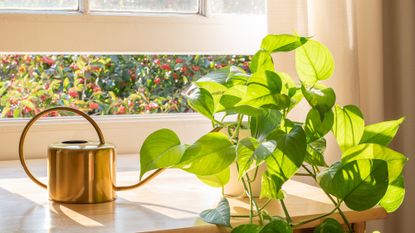Pothos plant care – how to guarantee pothos success
Discover expert pothos plant care tips to get the best out of this glossy trailing houseplant
- (opens in new tab)
- (opens in new tab)
- (opens in new tab)
- Sign up to our newsletter Newsletter


Good pothos plant care is essential if you want this lush, leafy plant to flourish in your home or garden.
Also known as devil’s ivy or the Rapunzel plant, pothos is the ideal plant for inexperienced growers, and makes for one of the best winter houseplants.
‘Pothos is an easy-to-maintain foliage plant that has low light requirements,’ says Rebecca Sears, chief gardening guru at Ferry Morse (opens in new tab).
‘It is most known for thriving in conditions that other plants wouldn’t survive, making it an especially perfect houseplant for beginners.’
As well as being a wonderful houseplant, pothos is also one of the best plants for hanging baskets in the garden, and makes one of the most beautiful additions to your conservatory ideas.
As long as you follow a few basic pothos plant care tips, growing success is almost guaranteed. The plants even have a reputation for being almost indestructible, hence the nickname devil’s ivy, and are also some of the easiest houseplants to grow from cuttings.
‘Pothos are mostly bulletproof in the interior plant world,’ says Shane Pliska, president of Michigan-based interior landscape company Planterra (opens in new tab).
‘Bear in mind that it can be difficult to buy plants with nice long trailing vines and well-developed roots, so if you have a pothos without trailing vines already started, you’ll need to be patient and watch it grow.’
However, you won’t require too much patience as the plant is exceptionally fast growing, and can grow around a foot per month in the growing season.

Pothos plant care tips
Even if you regularly neglect your pothos plant, it will likely keep on growing – so don’t worry about missing the odd watering.
‘Pothos is really hard to kill,’ says Eli Manekin, founder of Loop Living (opens in new tab). ‘And if you do accidentally kill your plants – don't worry! Just cut off the stems and keep going. More often than not it will start growing again.’
However, you don’t just want your plant to survive – you want it to thrive, and for its leaves to be lush and abundant. So make sure you understand the key portos plant care requirements.
How often to water pothos
An important part of pothos plant care is to give it the right amount of water. Ideally check to see if the plant needs watering every week or so – and only water it when the soil has dried out.
‘Don't be tempted to overwater a pothos – instead take your cue from the plant itself,’ says Manekin.
‘Wait until the leaves are soft and droopy, as that's when it needs to be watered. You can take a leaf in your hand and try to bend it – when it feels almost lifeless it's time to water.’
If you keep your pothos plant in a moist environment, such as the bathroom, you will find it needs watering even less often.
If you're wondering 'why is my pothos turning yellow?' it could be that you are watering it too much or too little.

Should I mist my pothos plant?
There is no need to mist your pothos plant. While the plants naturally grow in tropical environments, they should be watered through the soil down to the roots.
As long as you aren’t overwatering your pothos plant, the occasional misting is unlikely to do any harm, but should not be used as a substitute for watering.
Pothos temperature requirements
The temperature range for optimum pothos plant care is between 70-85°F (21-30°C). It can survive occasional low temperatures of 50°F (10°C) and high temperatures above 90°F (32°C) – but it won’t grow as well.
If you are keeping your pothos in the garden, then it will need to be brought indoors once temperatures have dropped in the fall.
Do pothos plants need a lot of sunlight?
While ideally pothos plants like bright, indirect light, they can survive in rooms that don’t receive much natural light.
‘The pothos plant is tolerant of lower light,’ says Pliska. ‘For environments without direct light, I particularly recommend the Jade pothos.’
The amount of light a pothos receives will also affect its appearance – ‘Pothos has beautiful white swirls on its bright green leaves, and the more light it's exposed to, the more these white streaks will be noticeable,’ says Kemp.
How to make pothos fuller
To make your pothos fuller, it’s important to prune it regularly, otherwise the plant will become leggy and start to take over the space.
To do this, cut the vines back close to a growth node, and remove any leafless vines.
Feed your pothos plant at every other watering during the growing season to help it grow as full as possible.
If your plant has become leggy, then a heavy pruning should help to revitalize it.
How often should I repot my pothos?
Pothos plants should ideally be repotted every two to three years, but if you allow your plant to grow quite large, then consider doing it every year.
If you don't do this, then the vigorous plant will become rootbound.

As editor of Period Living, Britain's best-selling period homes magazine, Melanie loves the charm of older properties. I live in a rural village just outside the Cotswolds in England, so am lucky to be surrounded by beautiful homes and countryside, where I enjoy exploring. Having worked in the industry for almost two decades, Melanie is interested in all aspects of homes and gardens. Her previous roles include working on Real Homes and Homebuilding & Renovating, and she has also contributed to Gardening Etc. She has an English degree and has also studied interior design. Melanie frequently writes for Homes & Gardens about property restoration and gardening.
-
-
 Valentine's Day gift ideas 2023: 24 last-minute luxuries for your loved ones
Valentine's Day gift ideas 2023: 24 last-minute luxuries for your loved onesFrom the timeless beauty of a traditional bouquet of flowers to unique houseplants and fun sweet treats, our selection of Valentine's Day gift ideas will be sure to inspire
By Zara Stacey • Published
-
 Robert Pattinson just bought a Spanish Colonial-style home – with an interior designer past
Robert Pattinson just bought a Spanish Colonial-style home – with an interior designer past'The Batman's' Robert Pattinson and Suki Waterhouse purchased the Jeff Lewis-designed Hollywood Hills estate for $5.3 million
By Megan Slack • Published

